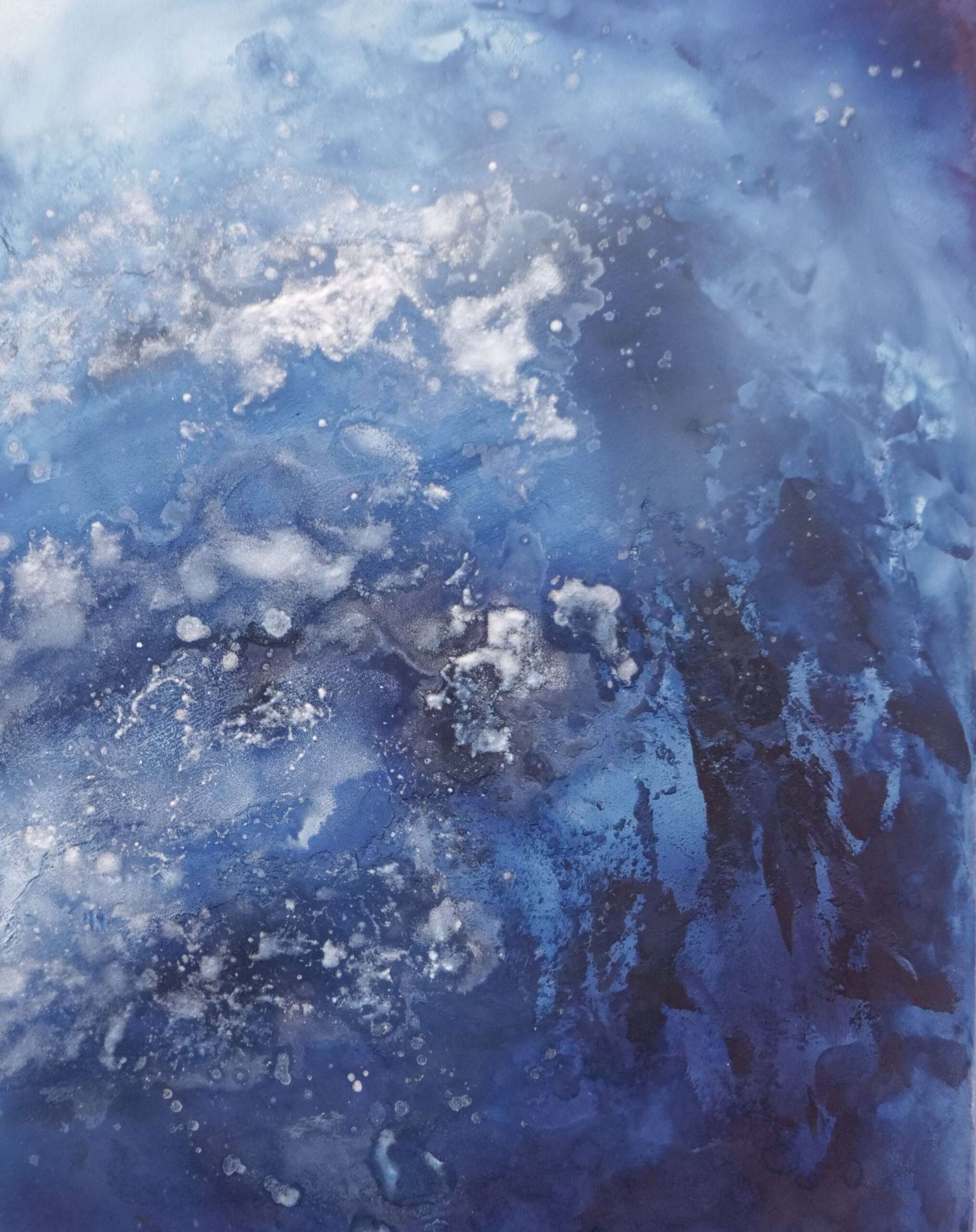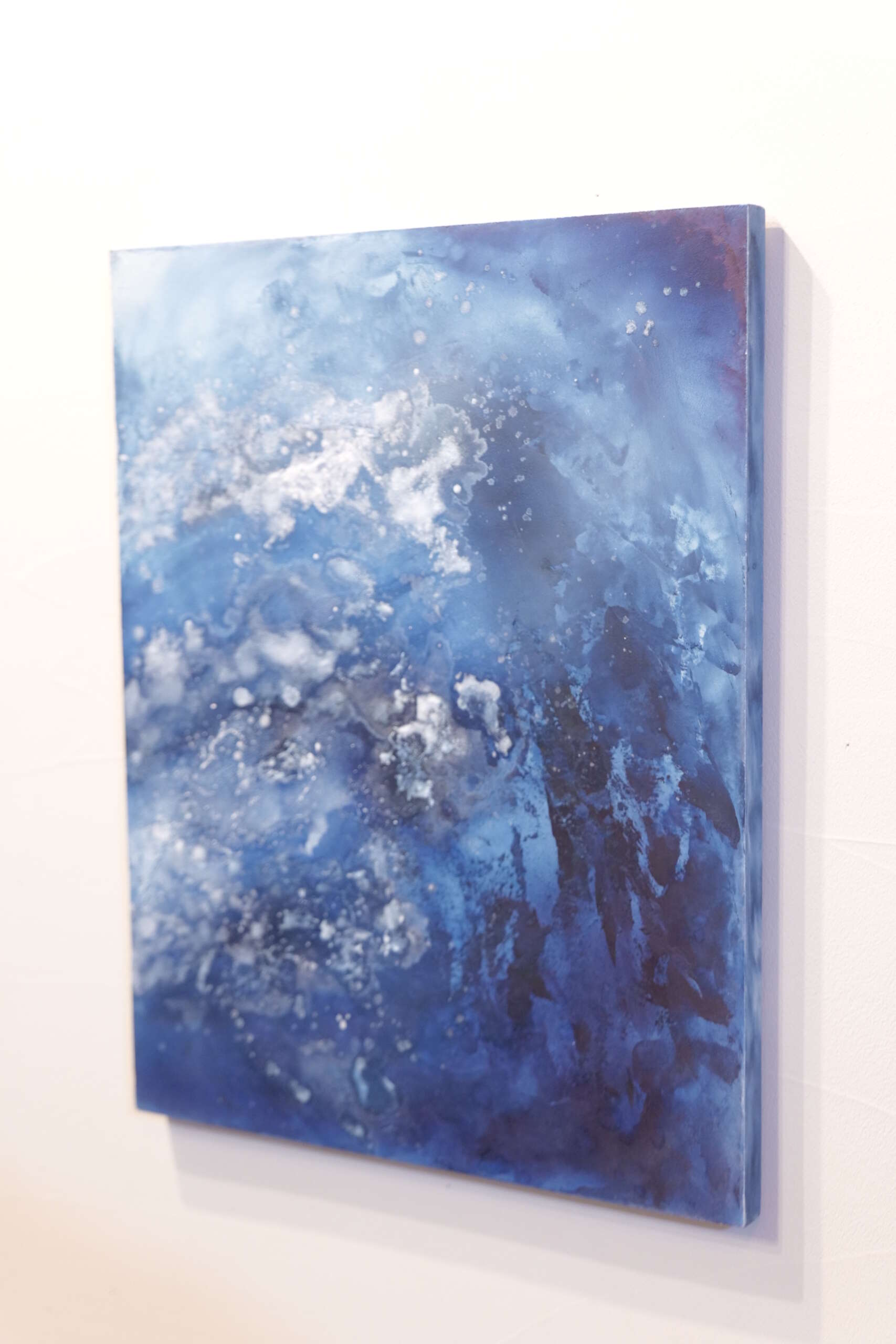2024年12月2日
新しい作品を制作した。
タイトルは仮に深遠藍讃としたが、作品のタイトルとしてはまだはっきりと決まっていない。
お察しの通り、私の愛読書のひとつ谷崎潤一郎の陰影礼讃からの影響でつけさせてもらった。
作品コンセプトは、"水の循環の一部に人の心があってほしい"という願いや祈り。
海や川、湖などは太陽のエネルギーによって蒸発し上空で雲となり、やがて雨や雪として川を流れて海へと戻る。
私たち人間は、この水の循環のなかにどのようにかかわっているのか。生活用水、工業用水、農業用水、マリンスポーツで浸かったりと様々だ。
人間が物理的に使うということは消費であって、汚すことなのかな。
もしも、この芸術作品(アート)が鑑賞者との間に介在することによって「涙」がこぼれたら、私たち人間は水の循環の中に美しく存在できるのではないか。
それは消費とは逆の立場にあって、連鎖する。
人間の新陳代謝で排泄されるものの中で汚物にならない、唯一の例外「涙」
字の成り立ちでは黎(れい)に通じ「すきまなくつらなる」流れる水という。
昨今の芸術は、資本経済のなかにあって"消費"の奴隷とされるケースも少なくない。
そうした消費活動すべてを否定するつもりはないが、偏りが大きくなっている現代社会においては、こうした作品がそれらを破壊する力を秘めている。
この作品は、2024年12月2日0時02分
友人のSendo / 千道 (現墨画家)からの連絡がきっかけとなった。
もう寝ていた私は、夜中に鳴ったスマホを開き、彼からの「ふと思ったから共有!」というLINEを目を細めながら読んだ。
読み終えた直後は、眠さもあってかそのまま寝ようとした。
おそらく5分ほど経ったであろうか、脳に電気が流れてスイッチが入ったようにビビッと目が覚め思考を巡らせた。
彼の「ふと思ったから共有!」もきっとそんな調子でビビッと来たのだろう。
なにかの啓示だと思い、朝一番で海へと車を走らせた。
塩を作るためだ。
普段はサーフボード片手に入るホームポイントの鵠沼海岸に、ビーカーと2リットルのボトルを手に、ジーンズの裾をまくりバシャバシャと海水に入った。
ここは大和市上草柳の泉の森に源を発した引地川をくだり、洪積台地を侵食して谷底平野を形成しながら湘南砂丘地帯へ流れ出て海へ注がれた場所。
10代の頃はサーフィンに明け暮れ、年間300日は浸かっていた。
江の島側から朝日が昇り、富士山へと夕日が沈む色彩がとても美しい場所だ。
河口が近い分、海は綺麗とは言えないが、それでも空気の澄んだこの時期は海水だって綺麗な時もある。
外面的な水の形態というのは、本質的なものではなく。むしろ水の持っている内面的なものへの「イマジネーション」
それを知らなければ、水の心まで語ることはできないと、なにかの記事で読んだことがある。
魂の浄化をするほど神聖なガンジス川が濁って汚れているのもそういう事なのだ。
海水を汲んでアトリエに戻ると、早速塩づくりをはじめた。
かなり待ち時間があるため、その時間を使ってキャンバスをつくり今年作った沈殿藍を左官技法で塗り始めた。
先月お亡くなりになった谷川俊太郎さんの言葉にこんなものがある。
「どんなに深く憧れ、どんなに強く求めても、青を手にすることはできない。すくえば海は淡く濁った塩水に変わり、近づけば空はどこまでも透き通る。人魂もまた青く燃え上がるのではなかったか。青は遠い色。」
なんとも心に響く。
自分が青に惹かれ、焦がれるのもこうした感覚に近い。
毎日を過ごす海、空の下。私は、この美しい遠い青を表現するために、少なからず人間ができる営みとしての制作を心がけ藍を育て色素を抽出している。
私は、アートにおいて、プリミティブやブリコラージュという思考を大切にしている。
脈々と受け継がれてきた藍の種を育て、手塩にかけてつくった沈殿藍を腕と金物ひとつの左官技法で表現する。
これは人間の視覚構造に与えられた青を見ることへの、せめてもの感謝の念と、人間のエゴで制作することへのある種の償いの結果である。
物理的に食べないと生きていけないように、芸術やアートは心や思考の集団意識のかけらとして、人間関係や社会が生きるために必要なもの。
さて、塩が出来てからは初めて素材(マテリアル)として使うため、慎重に制作を開始した。
水で溶いたり、結晶をそのまま乗せたりしながら。
透明、半透明の塩は、乾いてこないとはっきりとその表情を見せてはくれない。
ここにもロマンを感じつつ、焦らずゆっくりと進める。
一枚のキャンバスの上で起こっているであろう物理現象はミクロの世界であるため、「感じる力」が必要とされる。
ある程度のところで制作の手を止めて、待つことにした。
1日過ぎ、2日過ぎ、思っていた通り日に日にその表情は変わっていく。
まるで日々表情を変えていく海や空を見ている気分で見守った。
5日経ったところで落ち着き、作品は完成した。
普段は教会の壁のように強い表層の作品が主体だが、海水(塩)を使うことで、脆さや儚さ、繊細な雰囲気が感じ取れる。
それから数日は作品と対峙し、豊かな時間を過ごした。
額装するため、近所の額工房「ラセット」にお邪魔し、相談をした。
作品について聞かれたため素材やプロセスを話すと、「なんだか、料理みたいですね。」と言われた。
農業で育てた藍と、海水で作った塩を金物で創造する。まったく仰る通りである。
農作物、自然の力、稲と妻、祭、感謝、祈り。
芸術の根本的概念とはまさにこのことではないか。
久しぶりのエッセイだからか、能書きをたくさん述べたが、今回の作品は「どの口がなにを言うかが肝心」と同様に
守谷玲太がつくる事に意味がある。
完成した作品画像とプロセス動画を事の発端である友人のSendo / 千道に送った。
すぐに電話が来て、彼は開口一番「お誕生日おめでとうございます!」と言った。(笑)
もちろん誕生日でない私は、すぐに”新たな境地おめでとう”と悟った。
翌日、葬儀屋を営む幼馴染で親友の功介から連絡が入り、興味深い話をもってきてくれた。
それは、個人を偲びながら行う海洋散骨の海で汲んだ海水で作品を作れないかといものだった。
功介とはずっと一緒にサーフィンをしてきた仲で、青春時代はここ鵠沼海岸に毎日浸かっていた。
日本中の海へサーフトリップして、バリ島にも一緒に行った。
そんな彼が今、人の生と死について毎日思考し仕事をしている。
あらゆる宗教的観点、心理的要素、経済や社会のなかでの立場、人それぞれの死への向き合い方を勉強し、伝えている。
まさかこんなことで繋がるとは想像もしていなかったが、芸術が人に寄り添うひとつの在り方として、挑戦していきたいと思う。
最後に、金沢21世紀美術館の展覧会BLUEより、キュレーターの言葉を紹介して手を下ろすことにする。
光のスペクトルにおいて、赤の長い波長がまっすぐ進むのに対し、青の短い波長は四方に拡散し、空間のなかに溶け込んでゆきます。手につかむことのできない空や水に象徴されるように、青はその深みにおいて認識される色であり、それゆえに古代より人々の憧憬の念を掻き立ててきました。地上に目を移しても、青い色をした自然物は非常にめずらしく、ラピスラズリは洋の東西を超えて珍重されてきました。また、かつて映画監督のデレク・ジャーマンが「ブルーは目に見える闇の色」と語ったように、青は光と闇、生と死のあわいに現れる色でもあります。そして人々が内省へと向かう今にあって、青は私たちの心にもっとも浸透する色と言えるかもしれません。
作品のプロセス動画 ↓
https://www.instagram.com/reel/DDEhTBCvN-g/?igsh=aWl6ODY1dGQ2anl6


December 2, 2024.
A new work of art was created.
I tentatively titled it “SHINEN RANSAN”(Distant and deep Ai-indigo praise) but it is not yet a definite title for the work.
As you may have guessed, I was inspired by one of my favorite books, Junichiro Tanizaki's “Ineiraisan”.
☆The concept of the work is a wish and prayer that “the human heart should be a part of the water cycle.
The energy of the sun causes oceans, rivers, and lakes to evaporate and form clouds in the sky, which eventually flow down rivers as rain and snow and return to the sea.
How are we humans involved in this water cycle? We use water for daily life, industrial use, agriculture, marine sports, and so on.
Is the physical use of it by humans a consumption, or is it a pollution?
If “tears” were to spill from this work of art (art) as it intervenes between the viewer and the artwork, could we humans exist beautifully in the water cycle?
It is the opposite of consumption, and it is a chain of events.
The only exception “tear” that is not a defilement among the things excreted by human metabolism.
In the origin of the character “tear,” it is connected to “rei,” which means “flowing water” that is “seamlessly connected.
In the capital economy of today, art is often regarded as a slave to “consumption.
We do not intend to deny all such consumer activities, but in today's increasingly biased society, such works of art have the power to destroy such activities.
This work was created on December 2, 2024, at 0:02 a.m.
A call from my friend Sendo / Sendo (now an ink painter) triggered the idea.
I was already asleep, but I opened my phone that rang in the middle of the night and received a line from him saying, “It just occurred to me, so I'm sharing! I read it with squinting eyes.
Immediately after I finished reading it, I tried to go back to sleep, probably due to sleepiness.
Perhaps five minutes later, I woke up with a start, as if my brain was electrified and turned on, and my thoughts began to wander.
He said, “I just thought of something, so I'll share it with you! I am sure that his “I just had a thought, so I'm going to share it with you!
Thinking it was an epiphany. I drove to the sea first thing in the morning.
I drove to the beach first thing in the morning to make salt.
I usually go to my home beach, Kugenuma Beach, with my surfboard in one hand and a beaker and 2-liter bottle in the other, rolled up my jeans, and splashed around in the sea water.
This is where the Hikichi River, which originates in the "Izumi no Mori" forest in Kamikusayanagi, Yamato City, flows downstream, erodes the Pleistocene plateau, forms a valley plain, and flows out into the Shonan sand dune area before emptying into the ocean.
When I was a teenager, I spent most of my time surfing, soaking myself 300 days a year.
It is a very beautiful place with the colors of the sunrise from the Enoshima side and the sunset from the Mt.
The ocean is not as clean as it could be due to the proximity of the estuary, but even so, the water can be beautiful at this time of year when the air is clear.
The external form of water is not essential. Rather, it is the “imagination” for the inner things that water has.
I once read in an article that without knowing this, it is impossible to talk about even the heart of water.
That is why the Ganges River, which is so sacred that it purifies the soul, is muddy and dirty.
After returning to the studio with the seawater, I immediately began to make salt.
Since there was a long waiting time, I used the time to make a canvas and began to paint the precipitated indigo I had made this year using a plastering technique.
Shuntaro Tanikawa, who passed away last month, had this to say.
No matter how deeply you yearn for it, no matter how strongly you seek it, you will never be able to obtain the color blue. The sea turns to muddy salt water when you scoop it, and the sky becomes crystal clear when you get close to it. The human soul also burns blue, does it not? Blue is a distant color.”
It is very heartwarming.
It is similar to this feeling that I am attracted to blue and long to see it.
The sea, under the sky, where I spend my days. In order to express this beautiful, faraway blue, I try to create art as something human beings can do, in no small part by growing indigo and extracting its pigment.
In my art, I value the idea of primitives and bricolage.
I grow indigo seeds that have been passed down from generation to generation, and express the precipitated indigo that I have created by hand with a plastering technique using only my arms and metal objects.
This is a result of his gratitude to the human visual structure for being able to see blue, and a kind of atonement for the human ego in creating his work.
Just as we cannot live without physical food, art and art is necessary for human relationships and society to live, as a piece of collective consciousness of mind and thought.
Now, after the salt was made, I began working carefully to use it as a material for the first time.
Dissolving it with water and putting the crystals on it as it was.
The transparent or translucent salt does not show its expression clearly until it dries.
While feeling a sense of romance here as well, I proceeded slowly and without haste.
The physical phenomena occurring on a single canvas are microscopic, so the “power of feeling” is necessary.
After a certain point, I decided to stop working and wait.
One day passed, then two days passed, and as I had expected, the expression of the canvas changed day by day.
I watched it as if I were watching the ocean or the sky changing its expression day by day.
After five days, it settled down and the work was completed.
Normally, his works are mainly strong surface works like church walls, but by using seawater (salt), one can sense the fragility, transience, and delicate atmosphere of the work.
The next few days were spent confronting and enriching the works.
To frame the work, I visited a nearby framing studio and consulted with them.
When I told him about the materials and process, he said, “It's kind of like cooking. He said, “It's kind of like cooking.
Indigo grown by agriculture and salt made from seawater are used to create metalware. He was absolutely right.
Crops, the power of nature, rice and wives, festivals, thanksgiving, and prayer.
These are the fundamental concepts of art.
Perhaps because it has been a while since I wrote an essay, I have said a lot of things that I am not very good at, but I would like to say that this work is as much about what Reita Moriya creates as it is about “which mouth is important for what it says.
But the meaning of this work lies in the fact that it was created by Reita Moriya.
I sent images of the completed work and a video of the process to my friend Sendo / Sendo, who started the whole thing.
He immediately called me and said, “Happy birthday! (Laughs). (Laughs)
Of course, it was not my birthday, but I immediately realized, “Happy new year!
The next day, I received a call from Kosuke, a childhood friend and close friend who runs a funeral home, with an interesting story.
He asked me if I would be interested in creating a work of art using seawater collected at the ocean scattering ceremony held in memory of an individual.
Kosuke and I have been surfing together for a long time, and in our youth we used to take a dip in the ocean here at Kugenuma Beach every day.
He has surfed trips to all the oceans in Japan and even went to Bali with me.
He is now thinking and working every day about human life and death.
He studies and shares all religious perspectives, psychological factors, economic and social standing, and how each person faces death.
I never imagined that we would be connected in this way, but I would like to challenge myself as one way for art to be close to people.
Finally, I would like to close my hand by introducing some words from the curator of the 21st Century Museum of Contemporary Art, Kanazawa's “BLUE” exhibition.
In the spectrum of light, the long wavelengths of red travel straight ahead, while the short wavelengths of blue diffuse in all directions and melt into space. As symbolized by the inaccessible sky and water, blue is a color that is recognized in its depths, and for this reason has been a source of admiration for people since ancient times. On earth, natural objects in blue are extremely rare, and lapis lazuli has been prized both in the East and the West. As the film director Derek Jarman once said, “Blue is the color of visible darkness. In this age of introspection, blue is perhaps the color that most permeates our hearts and minds.

 松坂屋静岡店アート&ラグジュアリーサロン Blanc CUBE
松坂屋静岡店アート&ラグジュアリーサロン Blanc CUBE